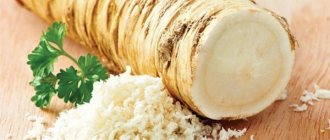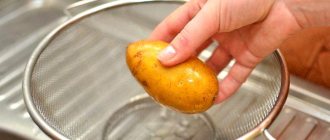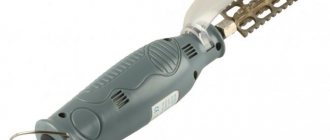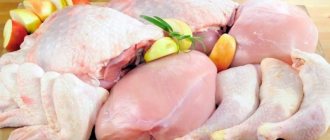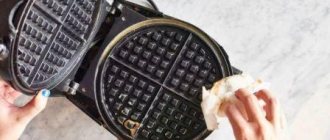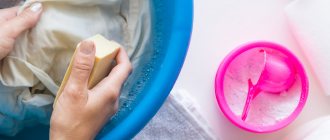Horseradish root is used in cooking, medicine and cosmetology. Most uses involve peeling the product and then grinding it. The plant contains essential oil, which has an irritating effect on the mucous membranes of the eyes, nose and mouth, so for a beginner, pre-treatment of horseradish root can turn into martyrdom. To avoid possible negative reactions of the body, read the recommendations and tips that will simplify this difficult process.
Do I need to peel horseradish?
For preparing dishes and preparations, mainly large horseradish root vegetables aged 2-3 years are used. Ideally, their length is 30-50 cm, and their diameter is from 3 to 6 cm (it is better to dig in September). Such rhizomes have a rather rough peel, which tastes too hard and unpleasant.
Therefore, in most cases it is necessary to peel horseradish. Although the young roots are covered with very soft skin. There is no need to clean it - on the contrary, it is better to leave it, since it contains many nutrients and beneficial substances.
Advice! It is not difficult to clean horseradish properly. But so that it does not lose its beneficial properties, you should start cooking immediately. If this is not possible, place the root vegetables in cold water and add ice cubes. Thanks to this, the roots will retain their taste and valuable vitamins and minerals.
Video
From the presented videos you can get information on how to effectively fight a plant invader from the cabbage family, and how to correctly use folk remedies:
About the author:
Found a mistake? Select the text with the mouse and click:
Ctrl + Enter
Do you know that:
Humus is rotted manure or bird droppings. It is prepared like this: the manure is piled up in a heap or pile, layered with sawdust, peat and garden soil. The pile is covered with film to stabilize temperature and humidity (this is necessary to increase the activity of microorganisms). The fertilizer “ripens” within 2-5 years, depending on external conditions and the composition of the feedstock. The output is a loose, homogeneous mass with a pleasant smell of fresh earth.
Top articles: Useful preparations: how to freeze beets
Do I need to soak horseradish before cleaning?
There are two opposing points of view regarding whether to soak horseradish. On the one hand, the rhizomes can be placed in cool water for 1-2 hours. Then a significant part of the dirt will come off on its own, and it will be easier to clean the roots. This really helps, especially if the pollution is strong. In addition, soaking helps soften the skin, the tissue of which absorbs moisture. If you have time, it is better to leave it in water overnight.
On the other hand, horseradish is easy to peel without soaking. If this is not possible, it is not necessary to place it in water. You can rinse under running water and start cleaning immediately.
It is worth keeping in mind that root vegetables release a large amount of caustic substances into the air. In this regard, horseradish dug up in September is especially dangerous. It should be cleaned especially carefully. It is recommended to wear a mask and goggles. If you grind in a meat grinder, a tight bag is first pulled over it.
Features of pruning remontant varieties
The types of pruning described above are used by gardeners on ordinary raspberry varieties that bear fruit once a year.
Remontant raspberry varieties are good because:
- bear fruit several times during the growing season;
- have high productivity, fruits appear already in the first year, since their replacement shoots have upper buds. Therefore, when some of the branches die off after a year, the amount of harvest from the bush decreases.
For remontant varieties, the pruning procedure is as follows:
- After the end of fruiting, the entire above-ground part of the dead branches is cut off.
- The soil around the bush is shallowly loosened and watered. This is done at the end of October or beginning of November, focusing on favorable weather conditions. During the winter period, the bush will not freeze and will gain strength for abundant fruiting next year.
- In the spring, when the buds swell, sanitary treatment is carried out: shoots that have frozen in winter or dried out are removed onto the first healthy bud.
All shoots of remontant raspberries are cut off after fruiting.
Next year, young, strong, healthy shoots will grow, which will give a good harvest of berries.
Raspberries are a fruit crop that, with proper care, will give the owner a bountiful and tasty harvest. By carrying out pruning in each growing season according to the rules, any gardener will achieve excellent results and a good harvest, will delight himself and his loved ones with aromatic berries and a medicine that is indispensable for colds in the winter.
Raspberries have been familiar to all of us since childhood. This tasty delicacy can be found in almost every garden, as adults and children love raspberries. This is a plant with the presence of annual and biennial shoots. Raspberries are usually low shrubs with a well-developed root system. The berry plant tends to produce good yields, and in order to ensure their stability, it is necessary to take into account that raspberries require proper care.
Raspberries rarely get sick, especially if you plant them in the right place. The condition of the soil will mainly influence the further development of the raspberry tree. The earth must have enough nutrients to supply the plants every year, then raspberries will always bring a bountiful harvest.
How to quickly peel horseradish root
There are different ways to properly peel horseradish root. The work requires thoroughness and accuracy, but in general it is completed quite quickly. To simplify it as much as possible, you should do this:
- Before cleaning, rinse the rhizomes thoroughly under running water.
- If you have time, soak for 5-10 hours in cold water. You can even leave it for a few days - it will only get better.
- To make cleaning easier, after soaking the horseradish rhizomes, place them in the freezer for 1.5-2 hours. The peel will freeze, and then it will be very convenient to remove it. This also prevents the excessive release of caustic substances into the air.
It is recommended to first keep the rhizomes in water for several hours or days.
Cleaning with a knife
Even if you don’t have special tools and equipment at home, you can peel root vegetables using a regular knife with a sharp and comfortable (quite large, stiff) blade. First, it is worth sharpening it again, since the surface of the root crop is uneven, and the blade must be almost perfect.
To properly clean the rhizomes, they are washed, if there is time, they are prepared according to the described scheme and then they begin to work. Dry it on a towel, rest the root on the table or hold it in your hands and cut it with a sharp knife blade.
Peeler
You can also peel horseradish for horseradish and other dishes using a regular vegetable peeler, which is also called a housekeeper. Root vegetables are held in one hand, and the other is passed along the surface with slight pressure. You need to act carefully and slowly so that the tool does not jump off the root. This method allows you to carefully clean the skin, including thin skin (from young roots).
Toothbrush
You can also clean the roots with a toothbrush, provided that it is hard (soft and even semi-hard ones work noticeably worse). First, the root vegetables are prepared, then placed in the sink, open the tap (small stream) and begin cleaning. To do this, brush along the rhizome, pressing and making sure that the skin is effectively removed.
Metal grater or sponge
If you need to clean horseradish quickly and easily, you can use a metal sponge (for dishes) or a fine grater. You need to work carefully so as not to cut your fingers. They act in exactly the same way as in the case of a toothbrush - open the tap and start cleaning.
High pressure washer
Another way to really quickly clean horseradish for horseradish and other dishes is by using a sink that uses high pressure water. For this you can use, for example, a Karcher device. Washing removes dirt well and allows you to remove the skin. This method is effective if you need to process large volumes of horseradish. Another plus is that thanks to washing, it is possible to avoid the release of large quantities of caustic substances into the air that irritate the eyes.
You can clean the rhizomes using a high pressure washer.
The sequence of actions is as follows:
- Prepare root vegetables.
- Place them in a net (bag).
- Turn on the pressure and direct the stream to the roots for several minutes.
- Pause the process and see how well the cleaning was done.
- If necessary, turn on the jet for a few more minutes and repeat the procedure.
The cleaning process is clearly shown in the video.
Traditional methods
How to quickly defrost minced meat: useful tips
Digging with a pitchfork A pitchfork, unlike a shovel, does not damage the horseradish root, but digs it up entirely. If there are no pieces of rhizome left in the ground, then horseradish will have nothing to grow from. The excavation must be repeated several times per season. Do not forget that you cannot leave the roots on the compost heap. The horseradish will sprout again and all efforts will be reduced to zero.
Rock salt An inexpensive and safe control option. Sprinkle the area with horseradish generously with salt. After rains or watering, the salt will be deeply absorbed into the soil and destroy the roots. It is advisable to repeat the procedure several times. You can use potassium salt. It is necessary to remove the ground leaves and fill the cut. Once absorbed into the root, the salt will corrode it. To speed up the process, you can pour hot water over the cut.
Acid Increased acidity of the soil is detrimental to horseradish. If you water the plant with vinegar or diluted citric acid, you can cause the roots to die.
Urea Remove the green leaves to expose the cut of the rhizome. Make cuts on the roots and add a pinch of urea. The plant cannot withstand such nutritional abundance and will perish.
Depletion Frequent cutting of the ground part, starting from the first shoots, will quickly lead to depletion and death of horseradish. The procedure is long, possibly for the whole season, but can bring good results.
How to peel horseradish without tears
To clean your roots safely, you can use these tips:
- put on goggles (better for swimming, they are sealed);
- be sure to use a mask to prevent inhalation of caustic fumes through the nose and mouth;
- use a thick bag.
Reception with the package is universal. It is used both for cleaning and grinding horseradish. You can put it on top of the grater and then scrape the roots. Or put it on a meat grinder and start chopping.
River perch soup - step-by-step video recipe
There are many options for preparing rich fish soup. Those who like to try fish soup are happy to stuff it or add all sorts of things to the dish: millet, rice, potatoes, and so on.
And now they have already received the stew.
And real fish soup is cooked over a fire in a pot or bucket, without unnecessary additives. Only onions and carrots. And they are traditionally cooked in three batches (later I’ll tell you the recipe for triple fish soup).
At the end, someone adds a glass of vodka and a charred apple tree branch. And I like it - the simpler it is, the tastier and more natural it is.
And they don’t “burp” real fish soup with spoons, but drink it!
By the way, this video also shows how to clean a perch with a car wash - funny. But it's simple and fast. True, the whole yard is most likely covered in scales. Okay, look:
Neither your tail nor your scales!
How to wash your hands after peeling roots
You need to clean horseradish carefully, and immediately after finishing work it is important to thoroughly wash your hands. They do this in order to eliminate caustic substances and too strong an odor.
You need to do this:
- Rinse off the residue under running water (they will fall on the mesh, from which you need to immediately shake off the solid fragments into a bucket or into a tight bag if there are a lot of them.
- Wash your hands with soap.
- Peel the lemon in advance, take the peel and rub it on your fingers, hold for 2-3 minutes.
- Cleaning your hands is quite simple - after using lemon, simply wash them with warm water and soap.
Instead of lemon, you can soak your brushes in a hot solution of warm soap, steaming for 10-15 minutes. They are then washed under water and lubricated with a nourishing cream to prevent dryness or irritation of the skin.
You can wipe your hands with a slice of lemon
Pruning raspberry shoots according to Sobolev
Back in the days of the Soviet Union, A.G. Sobolev proved that six kilograms of berries can be harvested from one raspberry bush. This man’s method of pruning bushes was a real discovery for all lovers of juicy and tasty raspberries. Many gardeners came to his house for advice to learn a unique way of growing raspberries. Since childhood, Sobolev was closely associated with agriculture, but it took him more than one year to obtain such a bountiful harvest from raspberry bushes.
You can also try this man's pruning method and get wonderful results. The essence of this method is to trim raspberry shoots within strictly designated periods.
The first pruning of raspberries is done in late spring or early June. When annual shoots grow from seven to ten centimeters to a meter, their tops are cut off. If you cut off each branch by ten to fifteen centimeters, this will further provoke high-quality growth of side shoots. You yourself will be able to observe how the axillary buds become active in a few days, and by the end of August in their place there will be shoots up to half a meter
Next year you will pick berries from these branches, so it is so important to strictly adhere to the timing of pruning.
The second time raspberry bushes need to be pruned next spring after they are already covered with foliage. In this case, the top of each side shoot should be removed by fifteen centimeters. After such treatment, by the fruiting period the raspberries will have several dozen more fruit-bearing branches with ovaries.
Pruning raspberries according to the method of A.G. Sobolev is popularly called double pruning. If you do everything correctly, you are guaranteed to succeed:
- Extend the harvest of conventional varieties, make it early and late, bringing the fruiting time closer, like remontant raspberries.
- Increase the number of flower buds on each bush.
- Increase the quality and quantity of the harvest.
Autumn pruning of bushes is carried out using the same technology as the traditional method. The raspberry plant is prepared for the winter by removing all immature, dry and diseased shoots, i.e., sanitary cleaning of the area is done.
Despite the simplicity of the Sobolev pruning method, when done correctly, gardeners ultimately receive the desired high yield. In addition to timely pruning of bushes, they also need to be watered and fertilized. There must be enough useful nutrients in the ground to ensure the normal development of the raspberry tree. If the shoots are pruned in time, the density of raspberry plantings will be most acceptable with strict limitation of side branches.
- When planting raspberries, make sure that the beds are located from north to south.
- To prevent raspberries from being exposed to long drafts and strong winds (especially in winter), it is necessary to plant bushes near a hedge or fence. The best landing spot will be the south side.
- Raspberries are not afraid of groundwater being close to the surface of the earth, so these plants can be planted in areas with such features.
- To obtain high yields, A.G. Sobolev recommends planting raspberries with a distance of one meter between the rows, and with the same distance between the bushes.
- If the groundwater is located at a considerable depth, or the area has a dry summer climate, then the plants must be watered frequently. An excellent option would be to raise the raspberry beds to a height of twenty centimeters above the level of the ground cover. To do this, you can build a special box, for which slate or boards are often used. This box will well retain moisture and applied fertilizers, which are so necessary for the raspberry root system. Thus, healthy nutrition is provided in the beds for the further growth of fruiting shoots. Not only commercial mineral supplements (superphosphate), but also natural humus in combination with potassium are well suited as bait for raspberries.
Depending on the region where raspberries are grown, you will need to try this pruning method several times until you find the best option. Raspberry growing areas have large areas, so agrotechnical practices may differ for individual areas. The path to successfully harvesting from raspberry beds can be found through the gardener’s own experience.
With beets
- Time: 1 hour 20 minutes.
- Number of servings: 5-7 persons.
- Calorie content of the dish: 56 kcal.
- Purpose: snack/condiment.
- Cuisine: Russian.
- Difficulty of preparation: easy.
Horseradish products are deservedly popular on the Russian table. This seasoning is healthy, has a specific aroma, and is indispensable for meat dishes. Making sauce with beets at home will help slightly soften the taste of the main component. Preparing the dressing is not difficult. A step-by-step recipe with photos will help you make the famous additive correctly.
Ingredients:
- vinegar (9%) – 2 tbsp. l.;
- granulated sugar – 1 tbsp. l.;
- beets – 100 g;
- horseradish – 200 g;
- water – 0.2 l;
- salt – 1 tsp.
- You need to start the cooking process by creating a marinade. Mix sugar, salt and vinegar in water. Place the contents of the pan on the fire, boil and cool.
- Beets need to be peeled and grated on a fine grater.
- The roots (one large horseradish) should be peeled and chopped using a blender or grater.
- Mix the prepared ingredients, pour warm marinade. Place into sterile containers and close. After waiting for the preserved food to cool, store it in the refrigerator.
We suggest you read: How to store horseradish for the winter
